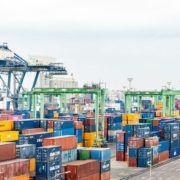Back to Basics: Port Terminals
Normally, it is easy to think about a particular port as one, indivisible entity. However ports themselves have a number of actors that comprise the overall port community. Just like pieces of a puzzle, port terminals are the different parts that make up a port. In this article we take a closer look at port terminals, looking at the kinds of port terminals that exist and at their corresponding characteristics.
What are Port Terminals?
“Ports are harbour areas in which marine terminal facilities are transferring cargo and passengers between ships and land transportation” by Dr. Jean-Paul Rodrigue and Dr. Theo Notteboom
Essentially, ports are areas where land and sea merge and where cargo ships and vessels dock to load and unload cargo, fuel and passengers. To facilitate this, ports are hosts to terminals. Depending on the size, they can have one terminal or several. These terminals, in turn, are specialised in the handling of the different types of cargo.
Terminals can be divided into three major categories:
- General Cargo (unitized cargo)
- Bulk Cargo (loose cargo)
- Passengers (passengers and vehicles)
Furthermore, within this division of categories of port terminals, more divisions can be identified, each serving a different purpose and classified by the type of traffic or cargo that is processed.
Divided by types of cargo these are:

Diving deeper, we can take a closer look at how these types of terminals operate. Let’s take a closer look at these terminal types.
- Container terminals
Perhaps the most easily recognised terminals in (cargo) ports are ones that can process containers. These terminals are designed to handle the large containers that are used to transport goods across the world. They have cranes and other handling equipment to move containers from ships to trucks or trains for further transportation.
- Roll-on/Roll-off (RoRo) terminals
As its name indicates, these terminals are used for vehicles -to roll on and off- like a cars, trucks, and buses that are driven onto ships for transportation. They have ramps or elevators to load and unload vehicles. A modern Roll-on/Roll-off (Ro-Ro) terminal is a facility designed to handle the loading and unloading of vehicles from ships quickly, efficiently and safely.
- Liquid terminals
When talking about liquid terminals we intend those handling liquids such as petroleum, chemicals and liquefied natural gas. For this, they have pipelines and storage tanks for the transfer of liquids from ships to land-based storage facilities.
- Dry bulk terminals
For handling dry cargo such as grain, coal, and minerals exist Dry Bulk Terminals. They have storage silos and conveyor systems to move the cargo from ships to storage or onto trucks and trains. These terminals are designed to ensure the safe and efficient handling of these goods, while minimizing the risk of damage or spoilage.
- Breakbulk terminals
These terminals exist for the handling of cargo that is too large or too heavy to be shipped in standard shipping containers. This type of cargo includes heavy machinery, steel, and lumber that is not packaged in containers, oversized equipment, etc. They have cranes and other handling equipment to move the cargo from ships to trucks or trains. Modern breakbulk terminals use technology to streamline the handling of cargo and minimize the risk of damage or loss, while also incorporating environmentally sustainable practices
- Passenger terminals
Designed to handle the boarding and disembarking of passengers on cruise ships and ferries, they tend to include amenities such as baggage storage, restaurants, and shopping areas for tourists. Modern passenger terminals are designed to provide a comfortable and efficient experience for passengers, while also ensuring the safety and security of people on board and their belongings, while also incorporating environmentally sustainable practices.
Conclusion
To summarise then it can be said that the type of terminal found in a port depends on the types of cargo and vessels that frequent the port. Some terminals specialize in handling specific goods, such as containers or liquids, while others are equipped to handle dangerous goods. Each terminal has its own unique features and facilities to handle specific types of cargo efficiently and safely. What determines the number of terminals in a port is the size of the traffic that frequents it – busier ports with better connections tend to be hosts to more terminals than smaller enclaves. Nevertheless all of them depend on the efficient management of said terminals and their successful operation is connected to the successful network within the existing port community.
If you are interested to know more, or if you’d like to witness port operations to a vessel or to goods, get in touch and check out our upcoming annual summer school on port operations.
Sources:


